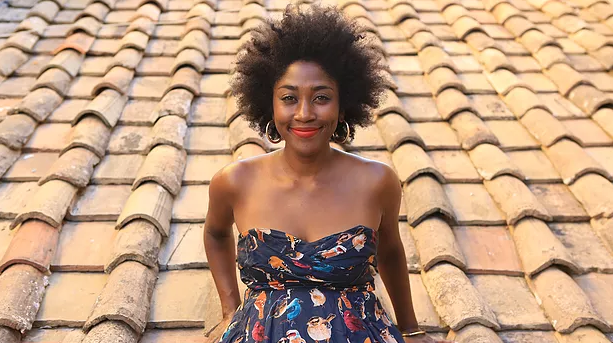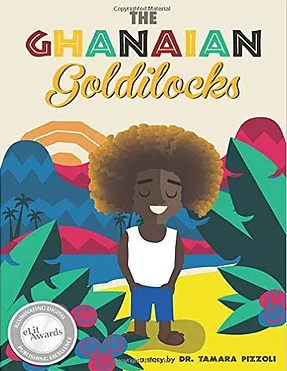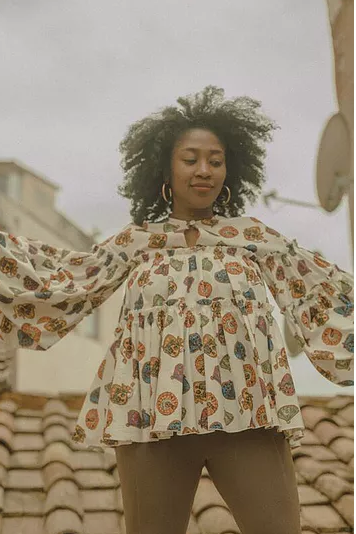African Picture Book Author Spotlight:: Dr. Tamara Pizzoli
Meet the lovely Tamara Pizzoli, Ed.D., author of over ten (yes, ten) children's picture books! Hailing from Killeen, Texas she now resides in Rome, Italy where she founded a school specializing in English-instruction for young children called, The English Schoolhouse.
However, The English Schoolhouse is not Tamara's first experience in the field of education. Tamara has studied in this field, obtaining a Bachelor's and Master's in Elementary Education and Teaching, as well as a Doctorate of Education in Educational, Institutional and Curriculum Supervision.
When I first learned about Dr. Pizzoli's book, “The Ghanaian Goldilocks,” I was captivated by interesting title and stunning visuals of black boy joy on the front cover. It is not too often that readers get to see African boys as the central character in a fairy-tale! Moreover, boys with Afros!
I was excited to see this book highlight African heritage in a meaningful way. Readers get the opportunity to enjoy a familiar story through the lens of Ghanaian culture and landscape. This book is a much-welcomed change from the Pan-African and non-country specific books that tend to dominate African-heritage titles.
We asked Tamara to share her story. She discusses her writing, her advice to other authors and her future projects.
For some background, tell us a bit about yourself. Where you are from and what you do?
I was born and raised in Killeen, Texas, but I moved to Dallas to attend Southern Methodist University when I was sixteen. I was a resident of Dallas for nine years before relocating to Rome in 2007. As far as answering the question “What do you do?” goes, I usually respond that I’m a creative. I do whatever I believe in and think is a good idea. I specialize in creative luxury. Currently that entails writing and publishing high-quality children’s literature (I have three titles that were picked up by Farrar, Straus & Giroux/MacMillan but I primarily publish through my boutique publishing house, The English Schoolhouse), curating high art, creative consulting, and making documentaries and web series.
When did you first become interested in writing for children? Did you always know you wanted to write African heritage books?
I think I first became interested in writing for children as a Kindergarten teacher. Reading aloud was always my favorite time of day with my students. I definitely didn’t know I’d have an affinity for writing the types of stories that I do, but I truly believe that all of us have these hidden gems within our psyches and our authentic selves that we’re able to tap into and share with others beautifully.
The book, The Ghanaian Goldilocks, re-imagines a popular fairy-tale. In what ways is it different and why did you decide to retell this story?
The Ghanaian Goldilocks was the very first book that I published and it was inspired by my eldest son, Noah. I was watching him one day at his uncle’s house and he was touching things he had no business touching and tasting things he had no business tasting. He was three years old at the time that I wrote the story, maybe four. I remember looking at him and jokingly asking, “Who do you think you are? Goldilocks?!” He thought that idea was hysterical and couldn’t stop laughing. The story, like all of the good stories I’ve written so far, really came so easily that it seemed to be writing itself. I just got quiet and still enough to catch the magic.
Did you have any fears or self-doubts when writing an African heritage children’s book? What were they and how did you overcome them?
No, aside from the fact that I’ve been to Ghana several times and I feel like I’ve had authentic experiences that I could easily draw upon, I know that Africa is my birthright. I had absolutely no hesitation or doubt about writing the story.
What advice do you have for authors writing African heritage children’s books?
Just start. There’s such a need. If you have a story in your heart that’s asking to be told, honor it by writing it down and sharing it. And then do it again, and again. There is someone, somewhere waiting to read the story that’s in your mind and heart right now.
What is your favorite African heritage children’s book?
I really adore Who’s in Rabbit’s House by Leo and Diane Dillon. It’s such a clever story. And the illustrations are incredible.
Any advice on how people can encourage children to read?
Children imitate what they see, so allow children to see you relaxing and reading. Also, when it’s time to read aloud to your kids, make sure that the titles are interesting and that you engage, really engage with the text. If you’re bored reading a book, the child is probably bored listening to it.
What are you working on next? Are there any other African heritage children’s books that you have written?
I'm always working on a ton of projects. In 2018 the following titles will be released by The English Schoolhouse:
The King and the Flute: A Nigerian Tale, illustrated by Maya N’Diaye
R is for Rose: A Floral Alphabet Book, illustrated by Elena Tommasi Ferroni
Jewels from our Ancestors: A Collection of African Proverbs, illustrated by Jamilla Okubo
Of Gods and Goddesses: Deities of Ancient Rome, illustrated by Elena Tommasi Ferroni
Of Gods and Goddesses: Deities of Buddhism and Hinduism
Of Gods and Goddesses: Deities of Ancient Egypt
I’m also currently filming a few documentaries and series with the phenomenal photographer/videographer Rikki Wright.
Regarding African heritage literature, one of the Of Gods and Goddesses books with Elena Tommasi Ferroni will be based on Yoruba deities like Oshun and Yemaya. I really can’t wait for that one.
Aside from that, I’d like for readers to note that not only is Goldilocks Black, but the tooth fairy is as well. (see: Tallulah the Tooth Fairy CEO). A lot of people don’t know that, strangely enough.
Connect with the lovely Tamara Pizzoli: Instagram | Facebook| Website| Media | Art
Check out her other works



